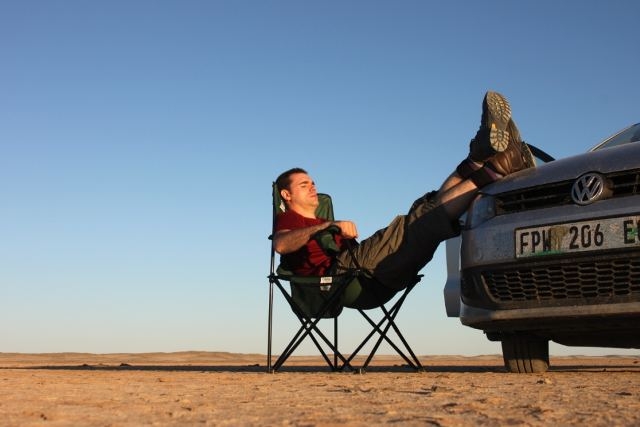
1K club Gold member James Howlett recounts his recent trip to to help build the world fastest race track on the Hakskeen Pan, South Africa:
On 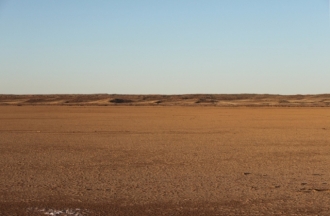 arrival in Upington I soon received the news from track boss Rudi Riek that track clearance work for the week of Mon 5th - Fri 9th September was off. Rudi advised me that he'd keep me posted on the situation and in the meantime I should take in a few sights and places. So with suddenly a week to kill I did just that. As a result I got to see a lot more of the Northern Cape than I otherwise would have done. The Augrabies Falls National Park is a particularly pleasant place to spend a day or two and - it being the right time of year - I was strongly recommended to head West and see the spring flowers of Namaqualand. Big detour out to Springbok but well worth it in the early South African spring. Plus, some of the lonelier stretches of the N14 highway between Upington and Springbok reminded me of Buzz Aldrin's description of the moon: Magnificent Desolation.
arrival in Upington I soon received the news from track boss Rudi Riek that track clearance work for the week of Mon 5th - Fri 9th September was off. Rudi advised me that he'd keep me posted on the situation and in the meantime I should take in a few sights and places. So with suddenly a week to kill I did just that. As a result I got to see a lot more of the Northern Cape than I otherwise would have done. The Augrabies Falls National Park is a particularly pleasant place to spend a day or two and - it being the right time of year - I was strongly recommended to head West and see the spring flowers of Namaqualand. Big detour out to Springbok but well worth it in the early South African spring. Plus, some of the lonelier stretches of the N14 highway between Upington and Springbok reminded me of Buzz Aldrin's description of the moon: Magnificent Desolation.
After my first week spent touring, it was time to head North to the Pan for week two. But by then I'd already had the update I was dreading from Rudi. Work was off for the following week as well. I now faced the prospect of spending a few days on the Pan completely alone. No point in Rudi coming up from Cape Town just for one visitor – but he put me in touch with a local man called Pastoor to show me around and help orientate myself.
James_Howlett_on Hakskeen Pan
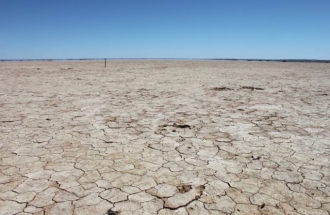 When one sets eyes on the Pan, one can't really take it all in. It's a slightly bewildering feeling of simultaneously seeing everything and yet nothing. The only visible reference to the project is a large notice halfway along the tar road which runs along the north side.
When one sets eyes on the Pan, one can't really take it all in. It's a slightly bewildering feeling of simultaneously seeing everything and yet nothing. The only visible reference to the project is a large notice halfway along the tar road which runs along the north side.
When I get to where I'm staying, Klipkolk Lodge, I'm offered a quick tour of the Pan by Hendrik Bott. I take Hendrik for a drive and he directs me along the western approach from Philandersbron, which will presumably be cut off when the time comes. Hendrik offered his local expertise to the Project early on, and he's clearly looking forward to when Bloodhound arrives, with the media circus and uncountable numbers of speed freaks that will accompany it. The approach roads are rather bumpy for my little hire car, but as we get onto the Pan proper, all suddenly becomes smooth. Hendrik points out the 500m safety zones either side of the main track, and the sheer scale of the task begins to hit home. Little piles of stones and thin metal fence posts mark each zone of the track running roughly north to south, and so we turn onto the track.
Accelerating on the long cleared section, I get somewhere near a tenth of a sense of what it will be like for Andy Green. The ground rushes fast under the wheels, but the features on the horizon barely move at all. At high 'ordinary car' speed, I fancy I can just begin to feel the car skating slightly, especially on firmer steering corrections, but I'm probably imagining it. Hendrik greatly enjoys the ride too - egging me on: "800......900........!"
Next morning, on the first of three full days I eventually spend on the Pan, Pastoor arrives at Klipkolk and we drive in convoy onto the Pan, stopping briefly to observe again the division of project territory into track and safety zones and the task still ahead of the team in levelling the causeway. At my request Pastoor agrees to show me where the track workers had got to when work was suspended. He leads me southwards down the eastern edge of the main track, keeping the stones and posts to our left for kilometre after kilometre. And then, quite plainly, the stones piles stop. We're there, perhaps a little over two-thirds of the way down the track. Having parked up, Pastoor warns me about the dust storms that can sping up.. It's just after 10am as he drives off, leaving me contemplating the vast, hot silence of Haskeen Pan.
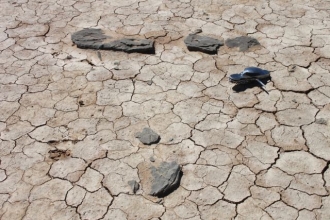 With no wheelbarrows or shovels available, I improvise with the smaller of my two luggage cases, my Bloodhound SSC laptop bag, and the cheap multi-tooled penknife I bought from a supermarket. At first, I just wander around aimlessly for a bit; plonk my luggage case down and work vaguely outwards from it in all directions. Roughly 20-25%% of the stones you can see are unattached and can be simply picked up. The rest need detaching. About half of those kick out quite easily with my sturdy walking boots and the other half require digging out from their sun-baked grip of the hard, cracked surface. It's pretty hard work in the heat of the day and I take frequent pauses for water as I acclimatise. I soon decide that I'm going to need a system. There are lanes marked out by thin rope and small stick markers at intervals across the track as well as along it - and I decide to work one lane: closest to the edge. Pacing out three large steps at each side I mark my area of clearance with my small case at one side and a packed-up mosquito net at the other. With laptop bag slung on shoulder I work my way slowly from the inside of my lane out towards the side of the track, just a couple of metres at a time. This system should give me some sense of achievement but even so can only ever be a gesture. But I'm glad I made it here.
With no wheelbarrows or shovels available, I improvise with the smaller of my two luggage cases, my Bloodhound SSC laptop bag, and the cheap multi-tooled penknife I bought from a supermarket. At first, I just wander around aimlessly for a bit; plonk my luggage case down and work vaguely outwards from it in all directions. Roughly 20-25%% of the stones you can see are unattached and can be simply picked up. The rest need detaching. About half of those kick out quite easily with my sturdy walking boots and the other half require digging out from their sun-baked grip of the hard, cracked surface. It's pretty hard work in the heat of the day and I take frequent pauses for water as I acclimatise. I soon decide that I'm going to need a system. There are lanes marked out by thin rope and small stick markers at intervals across the track as well as along it - and I decide to work one lane: closest to the edge. Pacing out three large steps at each side I mark my area of clearance with my small case at one side and a packed-up mosquito net at the other. With laptop bag slung on shoulder I work my way slowly from the inside of my lane out towards the side of the track, just a couple of metres at a time. This system should give me some sense of achievement but even so can only ever be a gesture. But I'm glad I made it here.
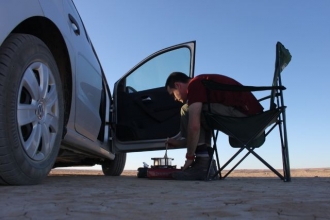 The second and third days pass exactly like the first. I have packets of dried fruit to keep me going throughout the day and I have couscous and tins of tuna and fruit for lunch. My multi-tooled penknife rarely leaves my hand all day - the fork, and spoon feed me and if you've ever wondered what that mystery thinnish tapered implement that nobody ever uses on a penknife is for - it's for digging up stones in a desert! When eating I listen to Radio Botswana. Knuckles scraped up, hands raw, knees and back aching, but it's great to be here. I know that at best I'm doing half a job: I can't repair any damage to the surface that results from some of the more challenging extractions, but the locals can take care of that with their shovels, and of course the Pan will flood and smooth over again anyway. By the end of the third day I've probably done about eight metres of my lane down the track from my start position. Approaching and departing my worksite each morning and late afternoon, I've taken full advantage of the fact there's no-one else around - flooring the accelerator and giving it the beans, imagining a record-attempt run of my own. A month later, I feel the fact that I missed out on working alongside the locals is nicely counterbalanced by what I got to see around the Northern Cape as a result. It's all served to leave me with a remarkable impression of the country's largest and emptiest province. With a fair wind, I'll be back - in 2013 or possibly even sooner.
The second and third days pass exactly like the first. I have packets of dried fruit to keep me going throughout the day and I have couscous and tins of tuna and fruit for lunch. My multi-tooled penknife rarely leaves my hand all day - the fork, and spoon feed me and if you've ever wondered what that mystery thinnish tapered implement that nobody ever uses on a penknife is for - it's for digging up stones in a desert! When eating I listen to Radio Botswana. Knuckles scraped up, hands raw, knees and back aching, but it's great to be here. I know that at best I'm doing half a job: I can't repair any damage to the surface that results from some of the more challenging extractions, but the locals can take care of that with their shovels, and of course the Pan will flood and smooth over again anyway. By the end of the third day I've probably done about eight metres of my lane down the track from my start position. Approaching and departing my worksite each morning and late afternoon, I've taken full advantage of the fact there's no-one else around - flooring the accelerator and giving it the beans, imagining a record-attempt run of my own. A month later, I feel the fact that I missed out on working alongside the locals is nicely counterbalanced by what I got to see around the Northern Cape as a result. It's all served to leave me with a remarkable impression of the country's largest and emptiest province. With a fair wind, I'll be back - in 2013 or possibly even sooner.
James Howlett

